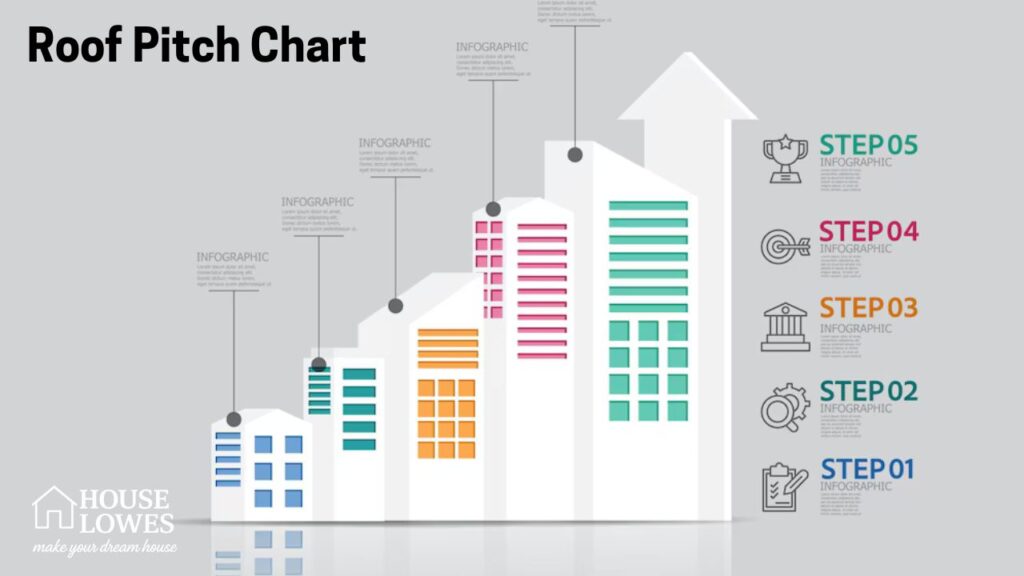Introduction to Roof Pitch
Imagine you’re building a treehouse, fixing your shed, or creating your dream home. One of the most important things to figure out is your roof’s pitch—but wait. What even is roof pitch? If you’ve seen terms like rise, run, angles, or roofing pitch chart thrown around and felt like someone was speaking another language, don’t worry! You’re in the right place.
We’re going to break down roof pitch step-by-step in a fun and simple way. This section is your gateway to understanding what roof pitch is, why it’s crucial, and how roof pitch charts make life easier for both beginners and experienced pros. Whether you want to learn how to read a roof pitch degree chart or how to use a roof pitch calculator chart, we’ll cover everything.
But first, here’s why roof pitch matters. Think of roof pitch as the angle or steepness of your roof. It’s what prevents water from pooling, keeps snow sliding off, and determines what type of materials you can use to cover it. Learn your roof pitch, and suddenly you’re a step closer to mastering roofing projects big and small.
What is Roof Pitch? (Friendly Definition!)
Alright, so what exactly is roof pitch? It’s basically the “tilt” of your roof. Imagine standing at the bottom of a hill and looking up. If it’s a gentle slope, you’re looking at a “low-pitch roof.” Steep incline? That’s a “high-pitch roof,” which you’d probably want to sled down.
Roof pitch is measured as the ratio between the vertical rise (how high the roof goes) and the horizontal run (how far the roof extends flat). For example, a 6:12 roof pitch means the roof rises 6 inches for every 12 inches it spans horizontally. Pretty simple, right?
There are three main ways roof pitch is described, and you’ll come across them often when exploring a roof pitch chart or how to use roof pitch conversion charts:
- Ratios (e.g., 6:12 or 4:12)
- Angles in degrees (e.g., 30° or 45°)
- Multipliers (values used for construction estimates and materials)
Each of these shows up in different types of charts, like roof slope multiplier charts, or roof pitch to angle charts. The good news? We’ll explain what they mean and how to use them without making your brain overheat.
Why Knowing Your Roof Pitch is Essential (Seriously, It’s a Big Deal!)
Think roof pitch isn’t that important? Think again. A roof pitch can affect everything, from how your home handles heavy rain to the type of materials you buy. Here are three reasons why understanding roof pitch is critical:
- Rain and Snow Drainage
A flat roof pitch (think slight tilt) works well in dry climates but could turn into a swimming pool in heavy rain. On the other hand, steep roof pitches gracefully shed snow and rain like umbrellas, making them a must-have in snowy areas. - Material Selection
Not all roofing materials work with every pitch. Asphalt shingles might thrive on a steep roof, while metal roof systems may be better for gentle slopes. If you’ve got a shed or want to use a metal roof pitch chart to calculate this, understanding pitch is everything. - Building Code Compliance
Local roofing codes may require specific pitches for safety or design reasons, especially in regions prone to hurricanes or heavy wind loads. Checking your roof pitch conversion chart can help make sure your project is up to code.
What is a Roof Pitch Chart, Exactly?
If roof pitch still feels a little abstract, that’s where roof pitch charts come in handy. Picture this as your cheat sheet for decoding roof pitch. These magical tools help you identify the angle, slope, and rise of a roof at a glance.
There are many types of charts, each serving different purposes, like these:
- Roof pitch to angle chart shows how pitch ratios convert into angles.
- Roof pitch slope multiplier chart helps you calculate construction material needs.
- Printable roof pitch charts are super useful to carry on-site for quick measurements.
- Roof pitch diagram charts visually lay out different pitch types so you can easily compare.
Here’s an example of how a roof pitch angle conversion chart might look if you’re sizing up your 6:12 roof pitch:
- 6 inches of rise over 12 inches of run = 26.57° angle of roof slope.
It’s simple math, but charts make it even easier to grasp!
With roof pitch charts in hand, you’ll confidently tackle any project, from drafting a shed roof pitch chart to figuring out multipliers for your dream lean-to roof.
Fun Fact! Ever Heard of the “12-12 Roof Pitch”?
Sounds like a dance move, doesn’t it? The 12-12 roof pitch simply means your roof rises 12 inches for every 12 inches it spans horizontally, creating a 45° steep slope. It’s common in dramatic designs, like Gothic architecture, and definitely worth mentioning in any guide about roof pitch angles charts.
FAQs About Roof Pitch (Quick Answers to Common Questions)
Want to get things cleared up fast? Here’s a quick roundup of common questions people have about roof pitch.
Q1. Can I use roof pitch degrees charts even if I’m not good at math?
Absolutely! Roof pitch charts like roof pitch to degrees charts simplify things, so you don’t have to wrestle with angles. Just match your ratio (e.g., 6:12) to its corresponding degree.
Q2. Are there free roof pitch charts available?
Yes, free roof pitch charts and roof pitch chart PDFs are widely available online. Pro tip: Print a few copies to bring with you when working!
Q3. What’s the easiest way to measure roof pitch?
Grab a level, a measuring tape, and a buddy. Use one end of the level to measure rise and mark the horizontal run. If it sounds tricky, many roofing calculators online (chart roof pitch calculators) can do this for you.
Q4. What’s the best roof pitch?
There’s no universal “best,” but commonly-used values include 4-12 roof pitch charts for modest slopes and 12-12 roof pitches for steep aesthetic projects.
Wrapping Up This Intro
We’ve hit a lot of points already, from understanding roof pitch to seeing how using roofing pitch charts simplifies everything. Whether you’re battling the elements with a flat roof pitch chart or admiring the dramatic tilt of a 12-12 roof pitch chart, this is just the start.
Don’t go anywhere yet—we’ve got everything from step-by-step DIY roof pitch measurement tools to advanced pro tips coming up in the next sections. Grab your gear (and maybe a cup of coffee)! Your roofing adventure is about to get even better.
Next in this series, we’ll explore How to Read and Use Roof Pitch Charts, where you’ll discover exactly how to turn those numbers, angles, multipliers, and diagrams into real-world results!



















